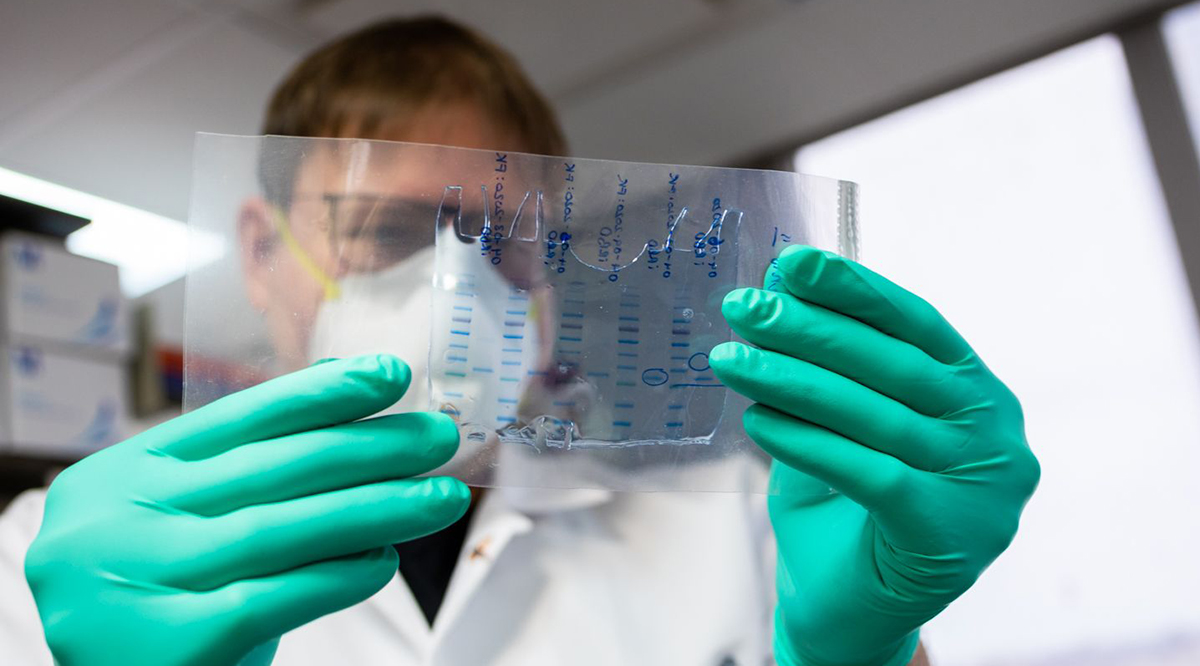
Florian Krammer, PhD, is impressed by how quickly medical science developed vaccines for COVID-19 — but not so impressed that he thinks everyone should be satisfied with bringing a vaccine to the public in just under a year after a viral outbreak. The lab researcher and professor of vaccinology at Icahn School of Medicine at Mount Sinai (ISMMS) in New York contends that by better preparing for future viral pandemics, research institutions can work together to produce safe and effective vaccines in as quickly as three months.
Krammer, the principal investigator at the Krammer Laboratory at ISMMS, recently spoke with AAMCNews about ideas to accelerate vaccine development. The interview has been edited for clarity and brevity.
The United States developed vaccines against COVID-19 in record-setting time — and much sooner than experts said we could expect. But you’ve said that still wasn’t fast enough. Why?
I don't think we were prepared. We had to basically start to make coronavirus vaccines from scratch. Although things moved very quickly, we had to go through Phase 1 trials, Phase 2 trials, then do large Phase 3 efficacy trials with the vaccines. That takes time.
We can do this more quickly if we are well prepared. For influenza virus, we get variants each year. And because there are already influenza virus vaccines with an established safety record and a known correlate of protection [measurable signs that a person is immune], we can just make a strain change to update the vaccine — without the need for lengthy clinical development.
If we do our homework, we could have a similar scenario for basically any kind of emerging respiratory virus that could cause a pandemic.
[Note: The first COVID-19 vaccines were built on research and testing conducted at academic medical institutions over the past 20 years, but scientists did not have the genetic sequence of the novel coronavirus that causes COVID-19 until after the pandemic began. The new vaccines then had to go through the typical three-phase clinical trial process.]

What would be the first step? You’ve talked about increasing virus surveillance in animals.
You need to know what's out there in order to get prepared. The viruses we are concerned about are zoonotic viruses that may jump from wild or domestic animals into humans. Emerging pandemic viruses typically come from the animal reservoir. We see this with coronaviruses: The coronaviruses that have caused recent outbreaks very likely came from bats originally. SARS-CoV-1 [severe acute respiratory syndrome] likely jumped from bats into civet cats and then into humans. MERS-CoV [Middle East respiratory syndrome] probably originated in bats and jumped from there into camels and then into humans. It is very likely that SARS-CoV-2 [COVID-19] took similar routes. The same is true with influenza: The 2009 H1N1 [swine flu] influenza virus came from pigs.
Walk us through animal surveillance. How do you find a virus emerging in animals, and what do you do with what you find?
We are especially worried about viruses that cause respiratory infections because they are hard to stop. Because we know which viral families usually contain such viruses, we know what to look for. Doing systematic surveillance in wild and domestic animals — especially where animals and humans come together (like wet markets, farms, and caves that house bats and are frequented by humans) — would help us see what’s out there and could cause trouble in the future.
You go through the viruses you see in nature or in domestic animals and say, “This might be a candidate for transmission to humans.”
Importantly, most of this surveillance is done by collecting genetic information — the viral sequence, not necessarily viruses themselves. We need to be able to predict from the sequence if a virus is potentially dangerous or not — like how likely a virus is to bind to human cells. This requires a lot of research.
What would be done after you find viruses that appear to be potentially dangerous for humans?
The idea is to select a few viruses as potentially dangerous and start making vaccine candidates against these viruses. If you make 50 or 100 vaccines, you probably could cover much of what could become dangerous to humans. You start Phase 1 trials with these vaccines and potentially expand that to Phase 2 trials. [Phase 1 and 2 trials are small, involving a few hundred to a few thousand people, and mainly address a vaccine’s safety and the immune response it causes against the virus.]
Fortunately, many potentially dangerous animal viruses already have family members that circulate in humans — like common cold coronaviruses, which are related to the COVID-19 virus, among others. While you are developing vaccines, you study what kinds of immune responses already work against the related viruses in humans. That allows you to establish so-called “correlates of protection” — an immune response that tells you if somebody is protected from the related virus.
How would you apply this knowledge to a pandemic that emerges in humans?
At some point, we will have all these vaccine candidates, and a new pandemic virus will emerge. We identify that virus, then we look: What is the closest related virus that we have made a vaccine for? If we are lucky, we already have that virus in our collection of vaccines — or we have one that is closely related. That is very likely, because we have made 50 or 100, and we know what viruses have been out there.
If the new virus is closely related to the ones we developed vaccines for, we do not need to develop a new vaccine from scratch. We just need to change the genetic sequence of the vaccine, similar to what we would do now with annual strain changes with influenza. Then we test the vaccine in a Phase 3 trial, which is larger than the first trials — maybe thousands of individuals. That gives us more data about the immune response in a wide variety of people.
And since we already established correlates of protection for those related viruses in humans, the vaccine gets authorized based on how well it produces the immune response that we know protects people from this type of virus. We do not have to do large and lengthy efficacy trials. We just need to assess immune responses in a much smaller number of people, which is much faster. If the immune response is strong enough, the vaccine is licensed and rolled out.
Are there other examples where we’ve stockpiled vaccines against a virus that we’re not fighting yet?
Yes, for influenza viruses. We have vaccines that are stockpiled for the H5 and H7 subtypes. But maybe not at a large enough scale.
The process you suggest could give us up to 100 vaccines sitting ready to go, and we won't need 99 of them because those viruses don’t emerge in humans. How do we convince people that this is worth the time and other resources that would take?
I don’t think there is much convincing needed at this point. Also, this is not something that the U.S. needs to do alone. Pandemic preparedness is something that the global community needs, and the cost could be distributed. With a few billion dollars, you could get a preparedness program that would put us in a much better position when it comes to mitigating the impact of emerging pandemic viruses.
Maybe we should rethink how we classify that kind of spending. It is a way of getting prepared against an invasion. It is not a foreign country; it is a little piece of RNA that invades us. You almost need to see this as defense spending. We should view pandemic preparedness similar to military spending.
A relatively small amount of money, compared to what the economy lost from COVID-19, would go a long way toward getting us prepared.
What would be the role of academic medical centers in this kind of preparation for future viral epidemics?
There are tons of things that academic researchers can contribute. All the virus characterization, the surveillance, etc. Influenza surveillance is often done by academic laboratories. Figuring out which pathogenicity signatures to look for in a virus is done by academic laboratories. Early vaccine development is done by academic laboratories.
Look at the work done by CEIRR [Centers of Excellence for Influenza Research and Response, a multi-institution network established by the National Institutes of Health to study the natural history, transmission, and pathogenesis of influenza and provide an international research infrastructure to address outbreaks.] That is basically academic researchers doing surveillance for characterization of potentially dangerous influenza viruses to prepare for coming pandemics. While U.S.-centered, it is a global network. It works really well and could be a model for a larger initiative.
